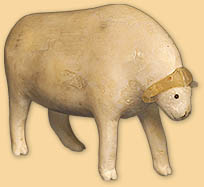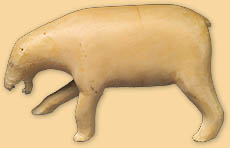 |
Quebec-born Captain Comer was unusual among the American whaling
captains during the nineteenth and early twentieth centuries because
he was fascinated by Inuit culture, and collected artifacts for Franz
Boas at the American Museum of Natural History. Many of his ethnographic
notes were published in Boas's classic, The Eskimo of Baffin Land
and Hudson Bay.*
After his whaling days were over, Comer served as ice master of the
George B. Cluett, a ship chartered by the American Museum of
Natural History. He also participated in other scholarly expeditions.
Comer eventually retired to Connecticut where he kept active in
community and state affairs until his death in 1937.
In 1913, the Canadian Museum of Civilization bought a large
collection of artifacts acquired by Comer during his whaling days.
Among them are eight ivories of Arctic animals.**
* Boas, Franz
1901 — "The Eskimo of Baffin Land and Hudson Bay. From notes
collected by Capt. George Comer, Capt. James S. Mutch, and Rev. E. J.
Peck." Bulletin of the American Museum of Natural History,
vol.15, part 1: 1-370.
** von Finckenstein, Maria
Winter 2002 — "Harry Teseuke, Captain Comer's Mate: Historic
Ivories at the Canadian Museum of Civilization, part II." Inuit
Art Quarterly, vol. 17, # 4, pp. 43-45.
Further Reading:
Comer, George
1906 — "Whaling in Hudson Bay, with notes on Southampton
Island" in Laufer, B. (ed.) Boas Anniversary Volume: Anthropological
Papers written in Honor of Franz Boas. New York: Stechert. pp. 475-484.
Ross, W. Gillies
1984 — An Arctic Whaling Diary: The Journal of Captain George
Comer in Hudson Bay 1903-1905. Toronto: University of Toronto
Press.

 |
Musk Ox, 1907–1909
Fullerton Harbour, West Coast of Hudson Bay, Nunavut
Ivory, musk-ox horn, black colouring
2.4 x 3.5 x 0.8 cm
CMC IV-C-51
Collected by Captain Comer while wintering over at Fullerton Harbour
between 1907 and 1909
|
 |
Comer's whaling station was at Cape Fullerton, close to today's
Repulse Bay. This musk ox is very similar to several collected by
A. P. Low when he wintered over at Fullerton Harbour during 1903–1904.
Another version, again very similar, is at the American Museum of
Natural History, also collected by Comer. It is noteworthy that they
all have horns made out of genuine musk-ox horn.
Reference:
von Finckenstein, Maria
2002 – "Harry Teseuke, Captain Comer's Mate: Historic Ivories
at the Canadian Museum of Civilization, part II."
Inuit Art Quarterly 17(4): ill. p. 44.
Polar Bear, 1907–1909
Fullerton Harbour, West Coast of Hudson Bay, Nunavut
Ivory, black colouring
4.2 x 5.5 x 1.1.cm
CMC IV-C-53
Collected by Captain Comer while wintering over at Fullerton Harbour
between 1907 and 1909
|
 |
 |
The explorer Hawkes included this bear in his book on the Labrador
Eskimo. He describes it as follows: 'Some carvings from the Central
Eskimo have caught in ivory the sense of action, as plainly as greater
sculptors in marble. { }... is a polar bear, with upraised foot on his
prey, warning off intruders."*
*Hawkes, Ernest William
1916 – The Labrador Eskimo. Ottawa: Geological Survey;
Anthropological series # 14, p. 101.
Reference:
von Finckenstein, Maria
2002 "Harry Teseuke, Captain Comer's Mate: Historic Ivories
at the Canadian Museum of Civilization, part II." Inuit
Art Quarterly 17(4): ill. p. 45.
Narwhal, 1907–1909
Fullerton Harbour, West Coast of Hudson Bay, Nunavut
Ivory, black colouring
Signed in brown ink: Harry
1 x 47 x 1.2 cm
CMC IV-C-55
Collected by Captain Comer while wintering over at Fullerton Harbour
between 1907 and 1909
|
 |
This miniature narwhal, with its tusk missing, carries the name of
the artist, a highly unusual occurrence among souvenirs from the early
1900s. Harry Teseuke was Captain Comer's mate, and chief of
the Aivilingmiut.
Exhibition History:
Inuit: Quand la parole prend forme. Organized by the
Muséum d'Histoire naturelle de Lyon, Lyon, France, December
17, 2002 – July 20, 2003; Musée de l'Homme, Paris, France,
November 1, 2004 – April 30, 2005.
Reference:
von Finckenstein, Maria
2002 – "Harry Teseuke, Captain Comer's Mate: Historic
Ivories at the Canadian Museum of Civilization, part II."
Inuit Art Quarterly 17(4): ill. p. 44.
Fish, 1907–1909
Fullerton Harbour, West Coast of Hudson Bay, Nunavut
Ivory, black colouring
1.1 x 5 x 0.6 cm
CMC IV-C-56
Collected by Captain Comer while wintering over at Fullerton Harbour
between 1907 and 1909
|
 |
This may well be the replica of an arctic char. Besides the fish,
Comer's collection of ivories at the Canadian Museum of Civilization
includes a fox, a wolf, a musk ox, a narwhal and a polar bear, most
likely all created by Harry Teseuke. It is possible that Comer
commissioned Teseuke to create a selection of Arctic wildlife for him.
|